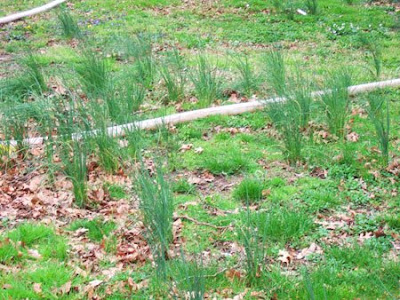 Barley Risotto with Nettle Leaves and Wild Onions.
Barley Risotto with Nettle Leaves and Wild Onions.
Last week, when we downed our sticky yet filling Nettle Pudding, we all agreed it could probably be adapted into something more appetizing.


 Barley Risotto with Nettle Leaves and Wild Onions.
Barley Risotto with Nettle Leaves and Wild Onions.
Last week, when we downed our sticky yet filling Nettle Pudding, we all agreed it could probably be adapted into something more appetizing.

 Nettle pudding.
Nettle pudding.
Nettle pudding has been declared Britain’s oldest recipe. From Epicurious.com:
***
Nettle pudding
Original recipe from Daily Mail UK Online
Ingredients
2 bunches of young nettle leaves
Any combination of 4 wild greens, such as:
bunch of sorrel
bunch of watercress
bunch of dandelion leaves
Some chives
1 cup of barley flour
1 teaspoon salt
Chop the herbs finely and mix in the barley flour and salt. Add enough water to bind it together and place in the centre of a linen or muslin cloth. Tie the cloth securely and add to a pot of simmering venison or wild boar (a pork joint will do just as well). Leave in the pot until the meat is cooked and serve with chunks of bread.
**

 Dandelion greens grocery store.
Dandelion greens grocery store. Left: Wild onion greens and lamb’s quarter, foraging in Queens. Right: Stinging Nettle
Left: Wild onion greens and lamb’s quarter, foraging in Queens. Right: Stinging Nettle Left: Adding flour and water, and forming into a ball. Right: The ball is wrapped in cheesecloth, and dropped into a simmering pot of hot ham water.
Left: Adding flour and water, and forming into a ball. Right: The ball is wrapped in cheesecloth, and dropped into a simmering pot of hot ham water.

Jerry Thomas writes in his 1862 Bartender’s Guide:
In such a household the art is still preserved. With her sleeves rolled up, the rosy granddaughter stirs sugar in a couple of table-spoonfuls of sparkling water, packs crushed ice to the top of the heavy cutglass goblet, pours in the mellow whiskey until an overthrow threatens and then daintily thrusts the mint sprays into the crevices. And the old man, rousing from his dreams, blesses the vision which seems to rise up from the buried days of his youth….
The mint julep still lives, but it is by no means fashionable. Somehow the idea has gotten abroad that the mint ought to be crushed and shaken up with water and whiskey in equal proportions. No man can fall in love with such a mixture. Poor juleps have ruined the reputation of the South’s most famous
drink.”
I like the idea that the mint julep was “out of fashion” in the 1860s. Perhaps because of the Civil War?
 The Kentucky Derby is upon us, and that means the start of mint julep season. Juleps are my hands down favorite drink; I’ve even purchased a few live mint plants so I can make them at a moment’s notice. Captain Maryatt, a 19th c British admirer of the American Julep, had this to say on the frosty drink:
The Kentucky Derby is upon us, and that means the start of mint julep season. Juleps are my hands down favorite drink; I’ve even purchased a few live mint plants so I can make them at a moment’s notice. Captain Maryatt, a 19th c British admirer of the American Julep, had this to say on the frosty drink:
I’m going to be introducing a new feature this week: Retronovated Recipes. Retronovation embodies a lot of what this blog is about: looking to the past to innovate the future. So I’m going to be sharing some of the recipes I’ve created that aren’t accurate recreations of historical recipes, but rather use the flavors of the past as inspiration. Keep an eye out.
 Burnt Almondy Ice Cream Goo.
Burnt Almondy Ice Cream Goo.
Boston, Little, Brown And Company (1896).
 Left: Makeshift double boiler. Right: Caramelizing the sugar. Do not try to taste the caramelized sugar by sticking your finger in it; its is very very hot and you will get burned very very bad. Like me.
Left: Makeshift double boiler. Right: Caramelizing the sugar. Do not try to taste the caramelized sugar by sticking your finger in it; its is very very hot and you will get burned very very bad. Like me.
Speaking on new/old products appearing on store shelves, Pepsi is releasing two new soda lines: Pepsi Natural and Pepsi Throwback. Their main selling point is that they are made with real cane sugar instead of high fructose corn syrup. According to Reuters.com: “Pepsi Natural, a premium cola made with sugar, natural caramel and kola nut extract, will be sold in glass bottles…The Pepsi and Mountain Dew Throwback drinks will be sweetened with natural sugar and will feature retro-looking packaging reminiscent of the 1960’s and 70s.” .
Kirsch Sorbet
Modern recipe adapted from The Chocolate Traveler.
Bring the milk, cream and sugar to a boil and simmer until the sugar has dissolved. Remove from heat and stir in the water. Add the kirsch to taste. Pour into ice cream maker and freeze for about 20 minutes. Transfer the ice cream to an airtight container and freeze until ready to eat. Garnish with cherry preserves.